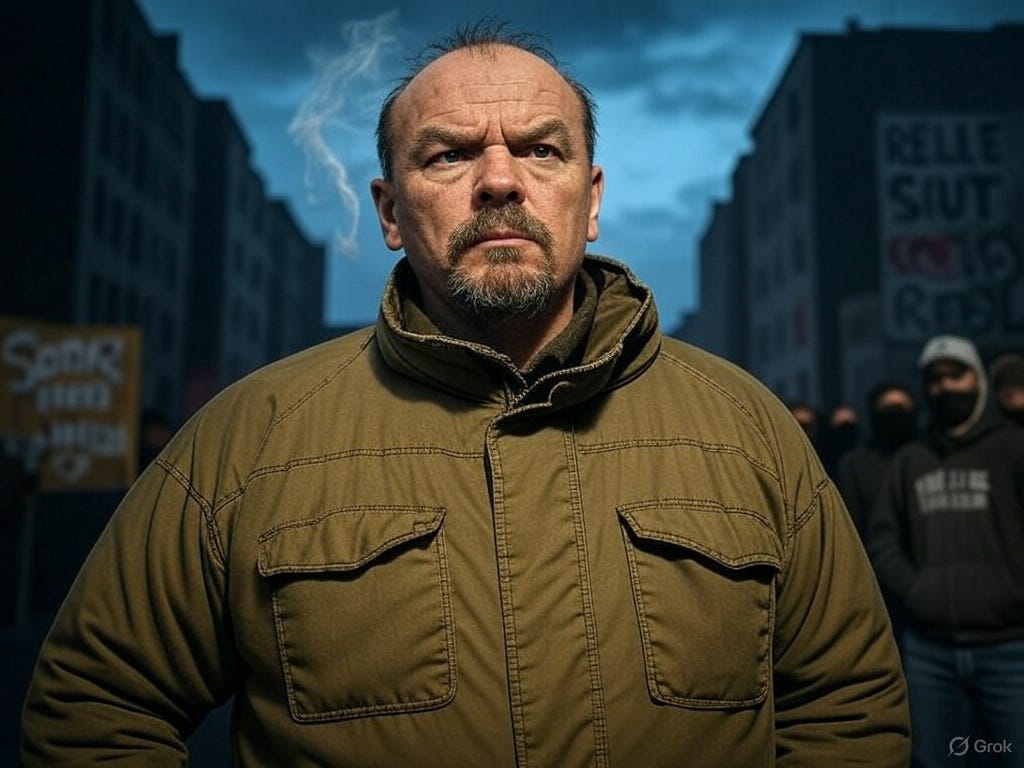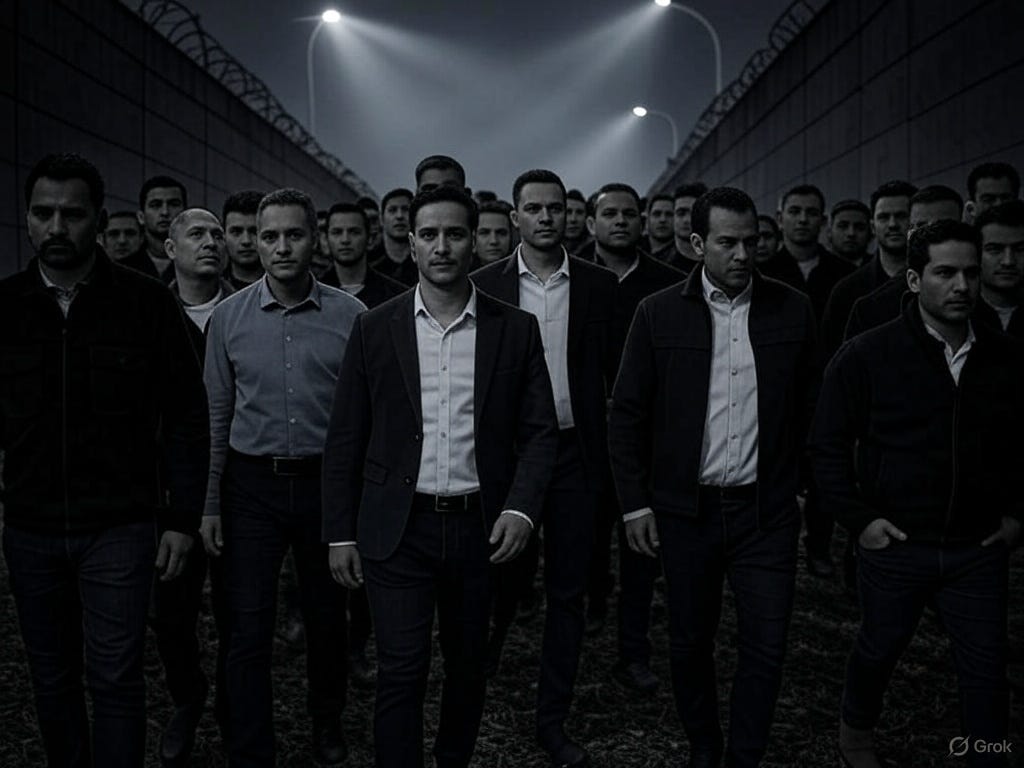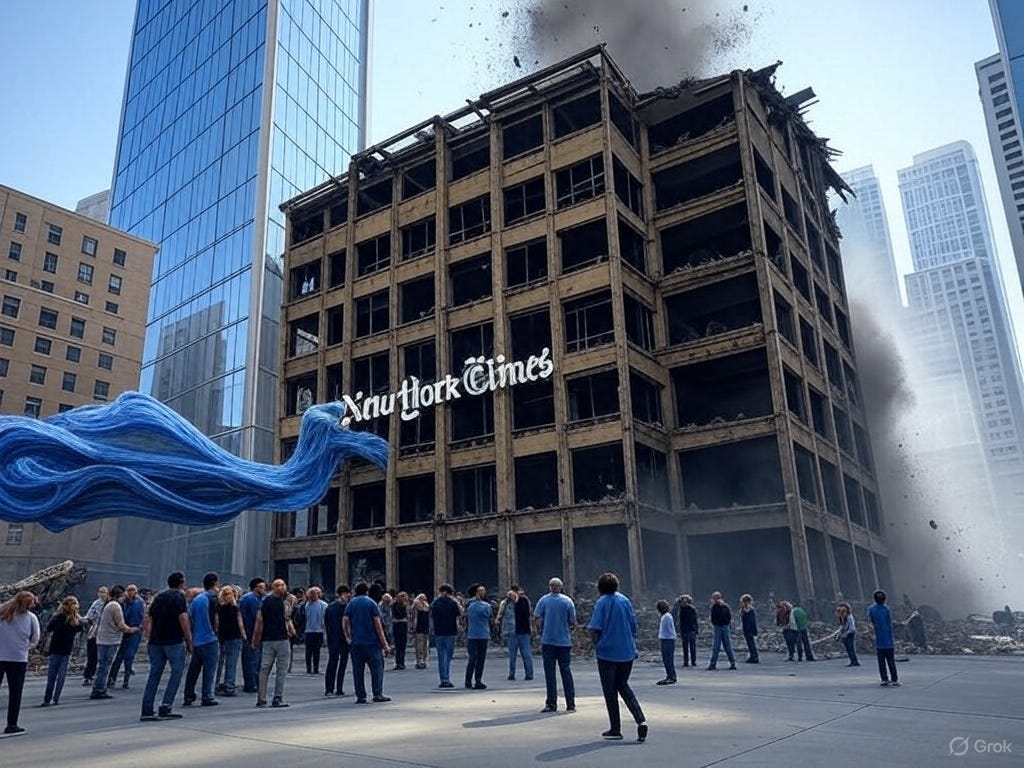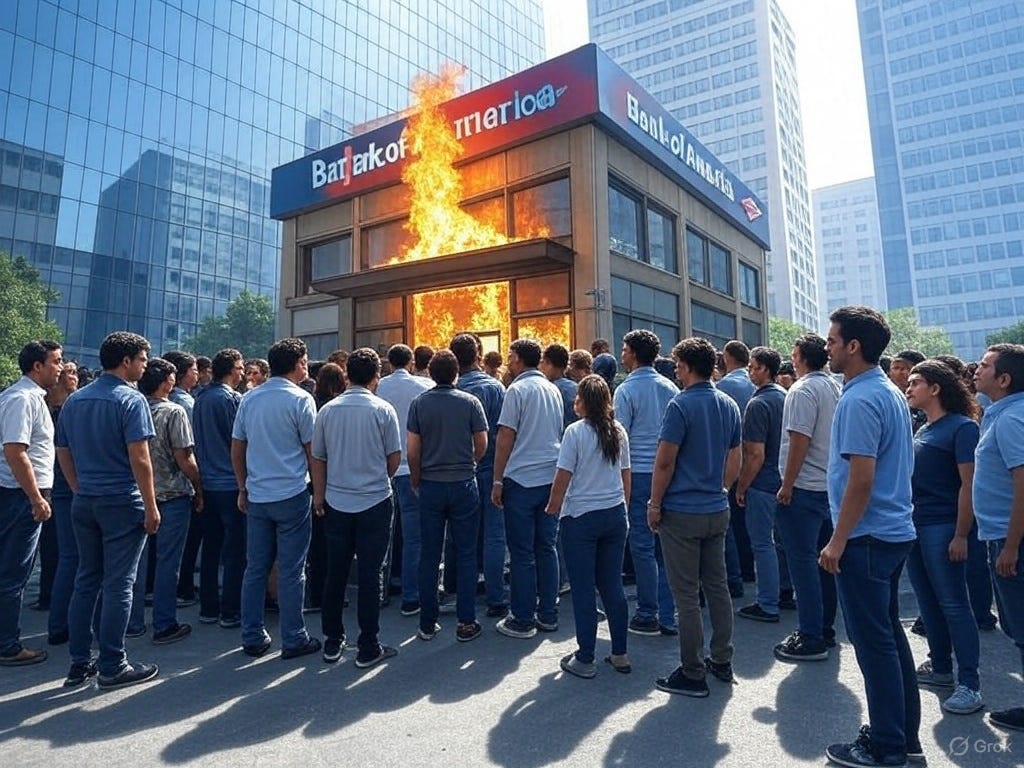Men and the City 52 - Chaos Media and the new Vanguard (The Hobbesian Moment Part 2)
Turning a generation of despair and division in young men into collective action.
Escape from Modernity
Men in the city want to escape. In the first essay of this series I highlighted a film that seemed to best capture the struggle of modern man - Fight Club. Since its release over 20 years ago, the film continues to electrify men of all ages, especially young men. Tyler Durden’s magnetism is polarizing among the sexes; in general, men are pulled like gravity toward’s the phenomenon and women are repulsed by it. Critics like Roger Ebert attacked the film as “macho-porn” and others derided it as “a movie about angry white men releasing their white male anger” (no doubt a movie about any other group’s anger would have won critical appraise). Among the themes that resonate so strongly in the film is the desire to escape from modernity.
Modernity has become a prison for most men. Consumerism, materialism, atheism, feminism, corporatism, wokism, globalism, Zionism etc. have spread like a cancer in the bloodstream of the West and beyond. Materialism fuels the gaudy wealth-porn fetishized in cities from Shanghai and Hong Kong to Singapore and Tokyo and completely warped female hypergamy. The distortion has so infected Asian fempolitans they scorn real-life men in favor of digital boyfriends. Most men find the techno-corporate ethos unbearable and a growing minority find it unlivable. Indeed, there is a festering masculine intolerance for the anarcho-conformity, spiritual emptiness, and nihilistic “freedom” of modernity.
The desire for escape has flamed into a compulsion to rebel.
The desire to escape has flamed into a compulsion to rebel as it did in Fight Club. Just as Jung and Nietzsche before him forecast, nihilistic modernity has finally provoked an alchemical shift in the psyches of young men, a Neo-Masculinity. Fight Club was an expression of the masculine collective unconsciousness becoming conscious, masses of men readying to mutiny against a broken, tyrannical modern world. Twenty years ago the Neo-Masculine mindset was embryonic and the frustrations men felt were difficult to define. Today, however, the battle lines between globalism and sovereignty, between feminism and traditionalism, between pluralism and masco-nationalism, between visible and invisible forces are solidifying.
The rank and file of the Neo-Masculine movement are masses of men but where exactly is the movement and who are its leaders? While signs of resistance are there they remain ethereal, scattered, and imperceptible to most. Further, in a time of such profound fracturing and disintegration how can we expect to unify into something bigger, something transformative and revolutionary? Why assume that the breakdown of authority detailed in Part I will not simply cascade into unrestrained Hobbesian anarchy without any restoration of civilized Western order?
From Legacy to “Chaos Media”
Just as Fight Club and other cult classics (Taxi Driver, the Matrix, Joker etc.) probed the depth psychology of modern men, a mirror into the Neo-Masculine awakening is to be found in mass media. Legacy media, the merger of telecom and media, peaked with the Telecommunication’s Act of 1996, which consolidated the media landscape in truly unprecedented ways. Deregulated ownership rules for media companies unleashed a furious agglomeration as companies like Clear Channel (iheartmedia) and Viacom scooped up TV, radio, newspapers and merged them into gigantic conglomerates that persist to this day. Fox News (launched in October of 1996), CNN and MSNBC quickly gobbled up smaller networks across verticals. Media became an oligopolistic machine like never before.
Consolidation meant legacy media exerted awesome power to platform the ideas, stories, candidates, and personalities they wanted while ignoring, marginalizing or targeting those they didn’t. Legacy media monopolized the megaphone, what CBS President Fred Friendly called “the master switch,” but as media power concentrated they lost something money cannot buy and propaganda cannot confer - authority. Trust in media has collapsed steadily for the last 20 years, punctuated by a combination death blow during the 2016 election of Donald Trump and Covid mania. Mainstream media has never recovered.
Loss of trust in legacy media created fragmentation. New media platforms like Facebook, YouTube, and Twitter emerged in the 2000s followed in the 2010’s by Instagram, Snapchat, and TikTok where young men get news today. The shakeup in media landscape was akin to blowing a hole in the death star of the industrial-media-complex. Hamish McKenzie, cofounder of SubStack, exclaimed, “We are living through the most significant media disruption since the printing press.” The printing press, incidentally, unleashed over a century of pent-up backlash against a totally corrupt Catholic Church. Likewise, alternative media transformed into awareness machines that spotlighted Epstein’s extortion racket, underground pedofile rings, CIA false flags, race realism, the JQ and more, all topics the legacy media covered up or censored.
Fragmentation ushered in “the age of chaos media.” McKenzie describes it as a manic bingefest of pulp-exposé:
“Traditional media’s rigid order has been replaced by mayhem. Conflict supersedes consideration. Speed overwhelms verification. This system is, in many senses, a marvel, with massive democratization potential. Anyone can have a voice, and your idea, if the winds blow just right, can reach billions of people in an instant…We’ve gone from catechism to cacophony.” - Hamish McKenzie
“Chaos media” is expert at disruption and destruction but it too lacks authority. Social media elevates “podium thumpers” who throw bombs and demolish facades rather than builders who construct movements or convey authority. The fury is reminiscent of the 70’s classic “Network,” a film from which I have derived the term Network Men, basically the influencers who lead online communities. I have compared these networks to the “Revolutionary Temper” of coffee houses inside the Palais-Royal before the French Revolution. Chaos media’s discordance is the fermentation of revolt, an adhesive force of dissent and division. But where is the cohesive force of consolidation, what is the coagulant of a new movement?
Let it Burn!
Institutions are ablaze because they have broken the social contract, all of them. Trust in legacy media faltered the minute it no longer “sought the truth and reported it.” Masses of men have lost faith in democracy, capitalism, Christianity and the nation itself. Voting changes nothing, grinding for dollars is soulless, God and nation have lost all measure of investible meaning in the day-to-day lives of men. It is too facile to blame the Gerontocracy or the “deep state” for violating the social contract when it is the system that has failed.
System failure has come with tremendous collateral damage. For Millennials and Gen Z the system is smashed beyond repair, it extends to the sexual marketplace, the 9:5 paradigm, and poisonous popular culture. For many, perhaps most young men, the hope for improvement in their everyday lives is a pipe dream so they rage on chaos media screaming “let it burn!” Everything from the Global-Dollar-System to pluralistic democracy and modernity itself need an overhaul.
The hope for improvement in their everyday lives is a pipe dream so they rage on chaos media screaming “let it burn!”
Masses of men are desperate for a reordering. What was once a fringe sentiment among Incels and MGTOWs is spreading to Gen X normies and even retired Baby Boomers who are noticing that things are not working. Gen X has put their faith in 401K matches and senescent Baby Boomers increasingly depend on social security as their sons and daughters move back home. What happens when stock markets crash and social security trust funds disappear as governments default? When housing prices propping up the net worth of millions of Americans pop and the greatest financial bubble in human history bursts with a vengeance - what then?
Influencers and Vanguards
The hard times of the Age of Scarcity are slowly merging the disparate crowd into a rebellious frenzy. In 1901 Vladimir Lenin penned an essay asking the same question many are asking today: “What is to be Done?” Lenin’s question was direct: How can we transform proletariat anguish into revolution? His answer was: an “organization of revolutionaries”, a vanguard. Unlike Marx, Lenin understood that “revolutionary consciousness is a product of theoretical insight, and a revolutionary movement is a product of political organization.” Collective action does not come from a mass awakening it comes from a vanguard.
Is there such a vanguard today? Yes - there is, it is in the cadre of influencers who lead chaos media. Influencers in the Manosphere, Crypto, the Alt-Right, and alternative media transmit revolutionary information. Calling flashy influencers, fiery conspiracy theorists, and macho-pyramid schemers (reminiscent of Tyler Durden) a vanguard may seem absurd, and prima facie it is. Yet influencers are the propagators of information that create “collective consciousness,” in today’s parlance red pill awareness. Robert Darnton argued that it was “a flow of information at the street level” that popularized revolutionary sentiment in France more than anything else:
“We often say that we live in an age of information, as if this were something new. Yet every period of history is an age of information, each in its own way, and in the eighteenth century, Paris was saturated with information transmitted by a multimedia system peculiar to its time and place.
Revolutionary Temper - Robert Darnton
Influencers have organized marginalized men into growing communities and sub-communities. However, as you can see from the graphic below, chaos media has stratified men into different silos and fostered in-fighting and divisive competition. As a result, there is highly flammable internecine rancor that sabotages teamwork or organization, and yet that is exactly what will happen. Remember, chaos media is still media, and information systems tend to centralize overtime. Chaos media, in other words, is a “moment of transition.” As McKenzie describes it: “What we’re seeing now could well be the emergence of a new media organism that hasn’t yet found its order.”
A vanguard is taking shape in the anarchy however erratically. At this point, network men and the awareness machines they propagate are still infantile and yet their influence, reach, and power is growing exponentially. Revolutionary principles embedded in masco-nationalism are proliferating. Men are remasculinizing, racial consciousness is surging, and elite overreach is becoming intolerable. What is lacking is a catalyst to streamline collective action.
Three years after “What is to be Done?” came another essay “One Step Forward, Two Steps Back,” an account of the schism between Mensheviks and Bolsheviks at the Second Congress of the Russian Social Democratic Labour Party. Then came the Ruso-Japanese War in 1905, a devastating loss for Tzar Nicholas II Lenin was convinced would sink the Romanovs permanently, but it didn’t happen. These setbacks irked Lenin who dogmatically believed that revolution would come even though it didn’t, until it did. Tragically, it was World War I that would reward the maniacal focus and political organizing of the tyrant’s tyrant and unleash his merciless apparatchiks on a vulnerable world.
Titanic events are always the accelerant and today is no exception. The masses of pissed off men who yearn for “sudden and spectacular change” is not enough to realize revolutionary liftoff. Influencers raging on chaos media is not enough and neither is the destitute condition of average men across the West. Only an exogenous catastrophe that cracks the edifice of legacy governmental authority will bring a true Hobbesian moment. What specifically could do so? What does a crack in governmental authority mean? These questions and more will be answered in Part 3.
Like, comment, subscribe and donate for more!












A financial collapse would be sufficient I would think, but a likely catalyst would be any bailing out of banks, hedge funds, major corporations etc. I don't think in this scenario that they could pull this off, as in the GFC, without furious backlash.
An exogenous disaster eh.....a natural or manmade disaster? We are overdue.